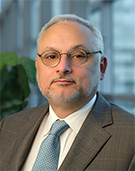Image-guided Video-assisted Surgery Helps Remove Small Lung Masses
Real-time image-guided video-assisted thoracic surgery procedures are helping remove small lung cancers less invasively at Brigham and Women’s Hospital



A multi-disciplinary team at Brigham and Women’s Hospital (BWH) that includes radiologists is demonstrating success with a new surgical procedure that combines video-assisted surgery with real-time imaging guidance to remove lung nodules while preserving healthy tissue.
While guidelines recommend surgical removal of lung nodules less than 2 centimeters in diameter that are suspicious for cancer, such removal presents a significant challenge for surgeons. Nodules located on pre-operative CT scans change position once the lung is partially collapsed for surgery.
“It’s like taking one point inside an inflated balloon and trying to find it after you deflate the balloon,” said Jayender Jagadeesan, PhD, a co-investigator of the clinical trial and a research scientist at the National Center for Image Guided Therapy (NCIGT), a National Institutes of Health (NIH)/National Institute of Biomedical Imaging and Bioengineering (NIBIB)-funded program at BWH and Harvard Medical School. The late Ferenc A. Jolesz, MD, served as principal investigator of NCIGT, which is now under the leadership of Clare Tempany, MD.
The surgeon can palpate the lung to find the nodule, but this method can be challenging with smaller nodules. As a result, surgeons can potentially remove large sections of healthy lung to ensure complete removal of the nodule.
“Thoracic surgery has evolved in the past decade toward minimally invasive surgery,” said study co-author Ritu R. Gill, MD, MPH, an associate radiologist at BWH and an assistant professor of radiology, Harvard Medical School, director of thoracic imaging and intervention, AMIGO. “Patients are living longer and may have more than one tumor in their lifetime. Surgical techniques are evolving to optimize resection and not take out more viable lung than is needed. This requires a multidisciplinary approach using intra-operative localization of lung nodules, allowing for targeted resection, decreasing operative times and morbidity.”
Drs. Gill and Jagadeesan were part of a multidisciplinary BWH team that recently studied a new procedure — real-time image-guided video-assisted thoracic surgery (iVATS) — to ensure lung nodule removal.
The procedure involves positioning the patient for VATS in a hybrid operating room, imaging the patient in the surgical position after the patient has received general anesthesia, placing two T-bars on either side of the lesion, followed by surgical resection of the nodule along with the T-bars. A T-bar is an example of a fiducial, or an object that provides a frame of reference for image-guided procedures.
T-bars were approved by the U.S. Food and Drug Administration for a gastrointestinal procedure, but Raphael Bueno, MD, chief of thoracic surgery and associate director of the BWH Lung Research Center, decided to investigate whether T-bars would be an improvement over the wires and hooks traditionally used as fiducials in lung imaging.
“The problem with wires is that they are stiff and the lung is soft, so they tend to migrate,” Dr. Bueno said. “T-bars are comprised of a metal tip attached to a thread, but they stay in place because the suture that holds them is flexible.”
Trials Performed at AMIGO Suite
Before starting clinical trials for the new procedure, the BWH team traveled to Memphis, Tenn., to perform animal studies. Over the course of an entire day, the team tested all currently used fiducials and found that the T-bar was the most reliable option.
Armed with this knowledge, the team began a clinical trial at BWH’s Advanced Multimodality Image Guided Operating (AMIGO) suite, a fully integrated operating suite offering immediate intra-procedural access to an extensive range of advanced imaging modalities. (See sidebar).
For the iVATS procedure, the radiologist uses the intraoperative scan in the operating room to help plan a route for placing the T-bars in the lungs. The radiologist and surgeon work very closely during this important part of the procedure.
“Because we are using imaging guidance, having a radiologist there makes it easier to identify the best approach to the nodule,” Dr. Bueno said.
The radiologist and surgeon use a needle under C-arm CT imaging guidance to place T-bars adjacent to the nodule site while the patient’s lungs are inflated. The goal is to mark the location as accurately as possible for surgical resection so that the actual placement is not always the one used traditionally for needle biopsies.
After the lung is collapsed, the T-bars, which are connected to a suture, extend through the pleura into the collapsed lung. The surgeon then uses the rigid thorascopoic video camera to locate the nodule by finding the region where the sutures come out to the surface of the lung.
“The sutures act as surrogate markers for the tumor,” Dr. Jagadeesan said.
After the nodule is removed, a specimen radiograph is obtained to make sure the T-bars and the nodule have also been included in the patient specimen before it is sent to pathology.
The BWH clinical trial included results from 24 consecutive patients with nodules ranging in diameter from 0.6 cm to 1.8 cm who enrolled. In several cases, the nodules had been discovered during low-dose CT screening.
iVATS Successful in Removing Lung Nodules
Results of the clinical trial, published last year in the Journal of Surgical Oncology, showed that the iVATS procedure was successful in removing the nodules in all patients and that the radiation dose was in the acceptable low range.
“These were not benign nodules,” Dr. Bueno said. “Out of 23 nodules removed, 22 were actually cancers.”
Along with preserving more of the healthy lung tissue, the iVATS procedure offers other benefits. The patient remains in the same room and in the same position throughout the procedure and only undergoes general anesthesia once. Operating room time is decreased, reducing risk of complications, and there is no migration of the fiducials.
“We now offer this procedure to patients as an optimal technique to remove small and ground glass and part-solid lung nodules,” said Dr. Gill, who serves on the RSNA Quantitative Imaging Biomarker Alliance (QIBA) Lung Density Biomarker and CT Volumetry Committee.
The BWH team is tracking the progress of the patients treated during the study while planning a second trial to compare outcomes of patients who undergo iVATS with those who undergo standard video-assisted thoracic surgery.
Dr. Jagadeesan anticipates that iVATS will become more common as hybrid operating rooms, or rooms equipped with advanced imaging capabilities, continue to proliferate and more radiologists and surgeons are trained on the procedure.
In addition, small nodules are expected to become a much more frequent finding in the wake of recent recommendations for routine lung cancer screening with low-dose CT in longtime smokers.
“Along with screening, we also needed to create downstream pathways to deal with nodules found incidentally on screening,” Dr. Gill said.
Eventually, the thorascopic video cameras and CT images could be fused together in what Dr. Jagadeesan called “augmented reality,” providing the benefits of both views on one monitor.
“This was a great team effort, not only among different specialties but between an academic hospital and industry,” Dr. Jagadeesan said.
Hybrid Operating Suite Expands Radiology’s Reach
The iVATS procedure for lung nodule removal is just one example of the advances made possible by the Advanced Multimodality Image Guided Operating (AMIGO) Suite at Dana-Farber/Brigham and Women’s Cancer Center in Boston. The 5,700-square-foot space includes three interconnected procedure rooms with real-time anatomic, functional and molecular imaging modalities, including MRI, PET/CT, CT-fluoroscopy and ultrasound.
The AMIGO Suite is directed by Clare M.C. Tempany, MD, the Ferenc Jolesz Chair of Radiology Research and principal investigator of the National Center for Image Guided Therapy, Brigham and Women’s Hospital (BWH); Raphael Bueno, MD, chief of thoracic surgery and co-director of the BWH Lung Research Center, serves as associate director of the AMIGO Suite.
“With the AMIGO Suite, we can bring as much information to the surgeons as possible while they’re performing the surgery,” said research scientist Jayender Jagadeesan, PhD, the technical lead for several of the procedures.
The suite allows multidisciplinary teams to collaborate and study new image-guided techniques for the diagnosis and treatment of many forms of cancer, including prostate, kidney, adrenal gland, bone, cervix, vagina and uterus. Specialists work together to plan and perform treatment without the patient or medical team ever leaving the operating room.
This innovative suite encourages collaboration among surgeons, interventional radiologists, imaging physicists, computer scientists, biomedical engineers, nurses and technologists.
As part of the National Institutes of Health-funded National Center for Image Guided Therapy, the AMIGO Suite serves as a national resource for all aspects of research into medical procedures enhanced by imaging.
For more information on the AMIGO Suite, go to www.brighamandwomens.org.